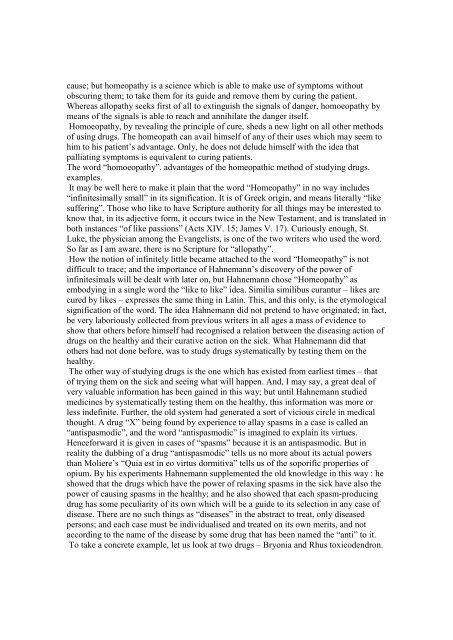CLARKE JH, Homoeopathy Explained - Classical Homeopathy Online
CLARKE JH, Homoeopathy Explained - Classical Homeopathy Online
CLARKE JH, Homoeopathy Explained - Classical Homeopathy Online
You also want an ePaper? Increase the reach of your titles
YUMPU automatically turns print PDFs into web optimized ePapers that Google loves.
cause; but homeopathy is a science which is able to make use of symptoms without<br />
obscuring them; to take them for its guide and remove them by curing the patient.<br />
Whereas allopathy seeks first of all to extinguish the signals of danger, homoeopathy by<br />
means of the signals is able to reach and annihilate the danger itself.<br />
<strong>Homoeopathy</strong>, by revealing the principle of cure, sheds a new light on all other methods<br />
of using drugs. The homeopath can avail himself of any of their uses which may seem to<br />
him to his patient’s advantage. Only, he does not delude himself with the idea that<br />
palliating symptoms is equivalent to curing patients.<br />
The word “homoeopathy”. advantages of the homeopathic method of studying drugs.<br />
examples.<br />
It may be well here to make it plain that the word “<strong>Homeopathy</strong>” in no way includes<br />
“infinitesimally small” in its signification. It is of Greek origin, and means literally “like<br />
suffering”. Those who like to have Scripture authority for all things may be interested to<br />
know that, in its adjective form, it occurs twice in the New Testament, and is translated in<br />
both instances “of like passions” (Acts XIV. 15; James V. 17). Curiously enough, St.<br />
Luke, the physician among the Evangelists, is one of the two writers who used the word.<br />
So far as I am aware, there is no Scripture for “allopathy”.<br />
How the notion of infinitely little became attached to the word “<strong>Homeopathy</strong>” is not<br />
difficult to trace; and the importance of Hahnemann’s discovery of the power of<br />
infinitesimals will be dealt with later on, but Hahnemann chose “<strong>Homeopathy</strong>” as<br />
embodying in a single word the “like to like” idea. Similia similibus curantur – likes are<br />
cured by likes – expresses the same thing in Latin. This, and this only, is the etymological<br />
signification of the word. The idea Hahnemann did not pretend to have originated; in fact,<br />
be very laboriously collected from previous writers in all ages a mass of evidence to<br />
show that others before himself had recognised a relation between the diseasing action of<br />
drugs on the healthy and their curative action on the sick. What Hahnemann did that<br />
others had not done before, was to study drugs systematically by testing them on the<br />
healthy.<br />
The other way of studying drugs is the one which has existed from earliest times – that<br />
of trying them on the sick and seeing what will happen. And, I may say, a great deal of<br />
very valuable information has been gained in this way; but until Hahnemann studied<br />
medicines by systematically testing them on the healthy, this information was more or<br />
less indefinite. Further, the old system had generated a sort of vicious circle in medical<br />
thought. A drug “X” being found by experience to allay spasms in a case is called an<br />
“antispasmodic”, and the word “antispasmodic” is imagined to explain its virtues.<br />
Henceforward it is given in cases of “spasms” because it is an antispasmodic. But in<br />
reality the dubbing of a drug “antispasmodic” tells us no more about its actual powers<br />
than Moliere’s “Quia est in eo virtus dormitiva” tells us of the soporific properties of<br />
opium. By his experiments Hahnemann supplemented the old knowledge in this way : he<br />
showed that the drugs which have the power of relaxing spasms in the sick have also the<br />
power of causing spasms in the healthy; and he also showed that each spasm-producing<br />
drug has some peculiarity of its own which will be a guide to its selection in any case of<br />
disease. There are no such things as “diseases” in the abstract to treat, only diseased<br />
persons; and each case must be individualised and treated on its own merits, and not<br />
according to the name of the disease by some drug that has been named the “anti” to it.<br />
To take a concrete example, let us look at two drugs – Bryonia and Rhus toxicodendron.
















